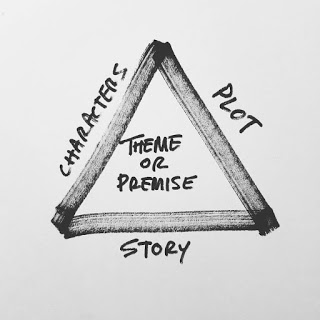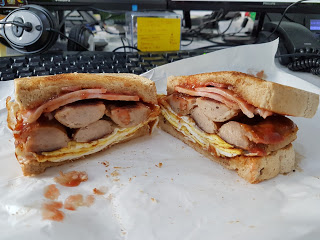In my own case I started out as an pencil artist (not a great one at that) and tried learning how to ink, then letter, coloring and lastly writing. Learning to write a comic book has probably been the hardest. With the other steps there are scores of YouTube videos, on line How-To articles and books on how to put the visual aspects of comics together. However, writing comics isn’t that easy, at least for me.
So, where do we start? How do you go from an idea to a piece of work that makes sense as a story?
A long time ago I read an online article that articulated how to make sense of an idea and progress it to a finished comic book. Unfortunately I can’t remember the site and author although I would love to credit where I found this information.
I’ll break the writing process into separate posts. But first lets talk about triangles.
Triangles… Doritos? Cheese triangles? Flying space triangles? No. The story triangle.
You will find that there
are four basic elements in constructing a story as illustrated by the diagram
below.
This is the “who”. Who are the main characters? Who are the supporting characters? Are some heroes or villains? What are their motivations and characteristics? Do they have personality flaws? Are they following a certain stereotype? What do they look like? How do they dress?
Lots of questions when it comes to characters but this is basically the “who”.
This is the “what”.
What do your characters want and what happens? It is the simple sequence of
events. For example:
Rosie wants to be on time for work. Unfortunately, she wakes up late.
Natalie makes her breakfast. Rosie eats breakfast quickly, dripping egg yolk on
her shirt. Now Rosie has to change her clothes, making her even later for work.
Rosie leaves the house in a rush, not looking in both directions before she crosses the street. Rosie is hit by a bus and dies. That is a plot.
That’s what
happens. The plot is the series of conflicts and resolutions leading to the
climax and ending where everything is tied together.
This is the where,
when, how, and why. Where and when are surface details, but they are important
as they determine how the character and society act and react. People in feudal Japan would not act in the
same way that Native Americans would act in 1800 America.
The plot described above with Rosie would have to happen in fairly large, modern city where cars and buses exist. It could not be transplanted
to France,
circa 1100.
the question of “What do you characters want?” by exploring how they
go about achieving their goals. We then ask the question of why should the
events of the plot matter to the characters and the readers.
story is the impact of Rosie’s death on Natalie, the bus driver, other characters,
and most importantly, on the reader. Why should the reader care about Jimmy’s
death and its ramifications? Therein lies the story.
Premise
Every story sets out to prove its theme or premise. In the story
outlined above, the premise might be “Remember to set your alarm clock so
you don’t wake up late.” The consequences of not setting your alarm clock
are then spelled out. The theme or premise does not have to be overly complex.
It can be as simple as “Love conquers all” or “Crime doesn’t
pay” or “With great power comes great responsibility” (sound familiar?).
It can be
much more complex, perhaps trying to prove or disprove the existence of a
higher power. It doesn’t matter how simple or complex your premise, as long as
everything in the context of the tale–the characters, the plot, and the
story–all relate to the theme in some way, shape, or form to your theme.
Ultimately, when someone asks what the story is about, they will usually zero
in on the theme or premise.
Also here is a pic of a breakfast sandwich. Why? Because breakfast sandwiches rule.

